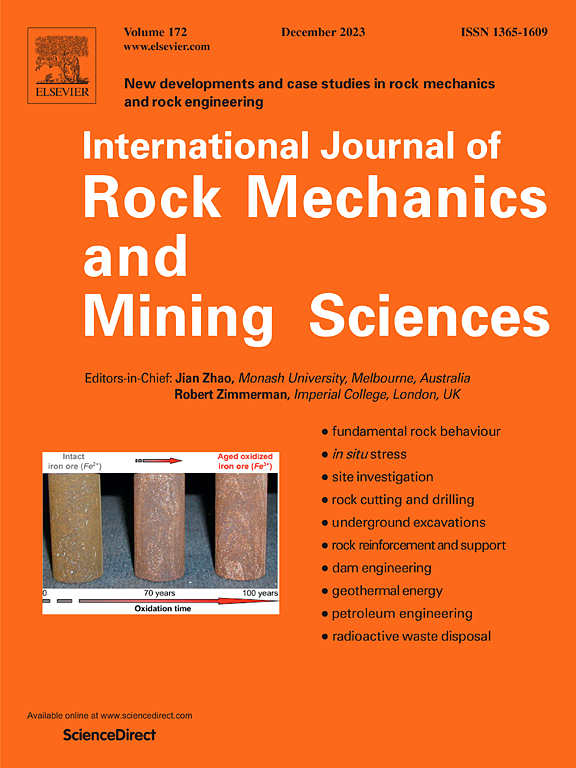量化纹层对页岩力学和损伤特性的影响:数字岩石模型的数值研究
IF 7.5
1区 工程技术
Q1 ENGINEERING, GEOLOGICAL
International Journal of Rock Mechanics and Mining Sciences
Pub Date : 2025-07-21
DOI:10.1016/j.ijrmms.2025.106218
引用次数: 0
摘要
具有发育良好的层状结构的沉积岩,如页岩,在层状属性的可变性和非均质性驱动下,表现出复杂的力学响应。量化单个层状属性对岩石力学响应的影响对于理解层状页岩复杂的变形和破坏机制至关重要,对地球科学和能源领域的地质应用具有广泛的意义。然而,在岩石实验中精确解耦与层压层相关的变量是一个挑战。我们开发了一个数字岩石工作流程,通过将ct导出的页岩微观结构与基于离散元方法的层状颗粒模型相结合,重建内部结构和层状特征,并使用实验数据校准每种层状类型的接触参数。模拟结果表明,增加软层(粘土)的数量,强度降低15%,模量降低35%;增加软层(粘土)的厚度,强度降低35%,模量减半,两者都提高了泊松比。相反,穿插硬纹层(二氧化硅)的页岩表现出相反的变化。层状材料性能的变化显著影响破坏过程中的微裂纹行为,使损伤模式复杂化。增加的片层数量和厚度增大了微裂纹演化的复杂性,其中软片层起主导作用,有利于剪切滑移,促进剪切破坏。通过分析软、硬纹层、边界区域和岩石基质的内应力特征,揭示了层状页岩的这些力学变化源于这些构造成分之间的应力不匹配。差异越大,力学对比越强,局部变形和破坏复杂性增大。我们的模拟与实验数据很好地吻合,突出了数字页岩建模的潜力,可以定量地将岩石力学特性与层状属性联系起来,同时提供关键的微观力学视角。本文章由计算机程序翻译,如有差异,请以英文原文为准。
Quantifying the effects of laminae on mechanical and damage characteristic of shale: Numerical investigation on digital rock models
Sedimentary rocks with well-developed laminated structures, such as shales, exhibit intricate mechanical responses driven by the variability and heterogeneity of lamina attributes. Quantifying the influence of individual lamina attributes on rock mechanical responses is essential for understanding the complex deformation and failure mechanisms of laminated shales, with broad implications for geo-applications across Earth sciences and energy fields. However, precisely decoupling lamina-related variables in rock experiments is challenging. We develop a digital rock workflow that reconstructs internal fabric and lamina characteristics by integrating CT-derived shale microstructures with a discrete element method-based laminated particle model, with contact parameters for each lamina type calibrated using experimental data. Simulation results show that increasing soft laminae (clay) quantity reduces strength by 15 % and modulus by 35 %, while greater thickness lowers strength by 35 % and halves the modulus, both raising Poisson's ratio. Conversely, shales interspersed with stiff laminae (silica) exhibit the opposite variation. Variations in lamina properties significantly affect microcracking behavior during failure, complicating the damage mode. Increased lamina quantity and thickness amplify the complexity of microcrack evolution, with soft laminae playing a dominant role by facilitating shear slip and promoting shear failure. Analysis of internal stress characteristics within soft and stiff laminae, boundary regions, and the rock matrix reveals that these mechanical variations in laminated shale stem from stress mismatches across these structural components. The greater the disparity, the stronger the mechanical contrast, amplifying localized deformation and failure complexity. Our simulations align well with experimental data, highlighting the potential of digital shale modeling to quantitatively link rock mechanical properties with lamina attributes while providing a crucial micro-mechanical perspective.
求助全文
通过发布文献求助,成功后即可免费获取论文全文。
去求助
来源期刊
CiteScore
14.00
自引率
5.60%
发文量
196
审稿时长
18 weeks
期刊介绍:
The International Journal of Rock Mechanics and Mining Sciences focuses on original research, new developments, site measurements, and case studies within the fields of rock mechanics and rock engineering. Serving as an international platform, it showcases high-quality papers addressing rock mechanics and the application of its principles and techniques in mining and civil engineering projects situated on or within rock masses. These projects encompass a wide range, including slopes, open-pit mines, quarries, shafts, tunnels, caverns, underground mines, metro systems, dams, hydro-electric stations, geothermal energy, petroleum engineering, and radioactive waste disposal. The journal welcomes submissions on various topics, with particular interest in theoretical advancements, analytical and numerical methods, rock testing, site investigation, and case studies.

 求助内容:
求助内容: 应助结果提醒方式:
应助结果提醒方式:


